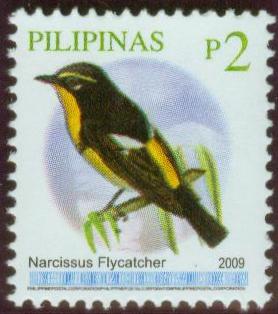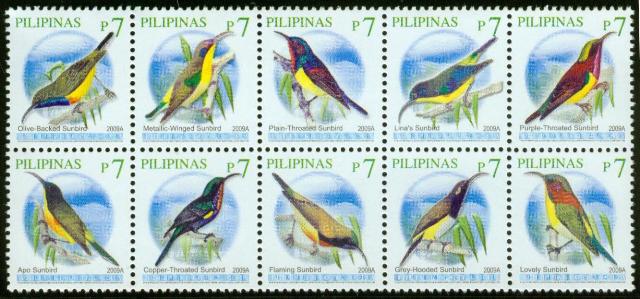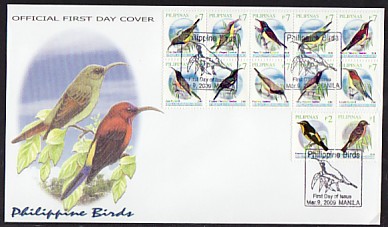2009, March 9. Philippine Birds - Definitives
Litho Offset. Amstar Company, Inc. Perf. 13.5
Singles, Sheets of 100 (10 x 10) (1p & 2p)
Se-tenant Blocks of 10 (10 Blocks per sheet) (7p), Sheets of 100

1p Mugimaki Flycatcher - Singles (1,950,000)
2p Narcissus Flycatcher - Singles (815,000)
1p Reprint marked "2009A" (June 2, 2009) (700,000)
1p Reprint marked "2009B" (August 6, 2009) (1,300,000)
1p Reprint marked "2009C" (December 11, 2009) (1,500,000)
2p Reprint marked "2009A" (June 2, 2009) (400,000)
2p Reprint marked "2009B" (August 6, 2009) (1,000,000)
2p Reprint marked "2009C" (January 11, 2010) (800,000)
Se-tenant Block of 10 (100,000)
7p Olive-backed Sunbird
7p Metallic-winged Sunbird
7p The Brown-throated Sunbird
7p Lina's Sunbird
7p Purple-throated Sunbird
7p Apo Sunbird
7p Copper-throated Sunbird
7p Flaming Sunbird
7p Grey-hooded Sunbird
7p Lovely Sunbird
7p x 10 - Reprint marked "2009A" (May 13, 2009) (410,000 SB/10)
Designs: All pictures taken from the book "A Guide to the Birds of the Philippines" by Robert S. Kennedy, Pedro C. Gonzales, Edward C. Dickinson, Hector C. Miranda, Jr., and Timothy H. Fisher.
First Day Covers: Manila
Official FDC Envelopes: 400 issued at P81 each
1p - The Mugimaki Flycatcher (Ficedula mugimaki). A small passerine bird of eastern Asia belonging to the genus Ficedula in the Old World flycatcher family, Muscicapidae. The name "mugimaki" comes from Japanese and means "wheat-sower". It is 13 to 13.5 centimetres long. It has a rattling call and often flicks its wings and tail. (http://en.wikipedia.org/wiki/Mugimaki_Flycatcher)
2p - The Narcissus Flycatcher (Ficedula narcissina). A passerine bird in the Old World flycatcher family. It is native to east Asia, from Sakhalin to the north, through Japan across through Korea, mainland China, and Taiwan, wintering in southeast Asia, including the Philippines and Borneo. It is highly migratory, and has been found as a vagrant from Australia in the south to Alaska in the north. (http://en.wikipedia.org/wiki/Narcissus_Flycatcher)
7p - The Olive-backed Sunbird (Cinnyris jugularis). Also known as the Yellow-bellied Sunbird. The Olive-backed Sunbird is common across southern China to the Philippines and Malaysia down to northeast Australia. Originally from mangrove habitat, the Olive-backed sunbird has adapted well to humans, and is now common even in fairly densely populated areas, even forming their nests in human dwellings. (http://www.redorbit.com/education/reference_library/birds/olivebacked_sunbird/3667/index.html7p - Metallic-winged Sunbird (Aethopyga pulcherrima). A species of birds in the Nectariniidae family. It is endemic to the Philippines. This species has a very large range, and hence does not approach the thresholds for Vulnerable under the range size. The population trend appears to be stable and size has not been quantified, but it is not believed to approach the thresholds for Vulnerable under the population size criterion. For these reasons the species is evaluated as Least Concern. (http://www.birdlife.org/datazone/species/index.html?action=SpcHTMDetails.asp&sid=8333&m=0)
7p - Brown-throated Sunbird (Anthreptes malacensis). Also known as the Plain-throated Sunbird, is a species of bird in the Nectariniidae family. It is found in a wide range of semi-open habitats in south-east Asia, ranging from Myanmar to the Lesser Sundas and west Philippines. The Grey-throated Sunbird found in the remaining part of the Philippines is often considered a subspecies of the Brown-throated Sunbird, but the two differ consistently in measurements and plumage. It is a relatively large, heavy sunbird with a thick bill. (http://en.wikipedia.org/wiki/Plain-throated_Sunbird)
7p - Lina's Sunbird (Aethopyga linaraborae). Lina’s Sunbird, common name for a small, colorful sunbird recently discovered in the Philippines. Lives in tropical forests at about 1200 m (about 4000 ft) on the isolated eastern mountains of the Philippine island of Mindanao. Its entire known range covers only about 800 sq km (about 300 sq mi). The Lina’s sunbird resembles a hummingbird with its long, curved beak used to sip nectar from flowers. (http://encarta.msn.com/encyclopedia_761595255/lina%e2%80%99s_sunbird.html)
7p - Purple-throated Sunbird (Nectarinia sperata or Leptocoma sperata). Also known as Van Hasselt's Sunbird, a species of bird in the Nectariniidae family. It is found in Brunei, Cambodia, India, Indonesia, Laos, Malaysia, Myanmar, the Philippines, Singapore, Thailand, and Vietnam. Its natural habitats are subtropical or tropical moist lowland forests and subtropical or tropical mangrove forests. (http://en.wikipedia.org/wiki/Purple-throated_Sunbird).
7p – Apo Sunbird (Aethopyga boltoni). A species of bird in the sunbird family Nectariniidae. It is endemic to the island of Mindanao in the Philippines. Its natural habitat is tropical moist montane forest. The species is not yet threatened by habitat loss, and is common within its range, but it is listed as Near Threatened due to its tiny range. (http://en.wikipedia.org/wiki/Apo_Sunbird).
7p - Copper-throated Sunbird (Nectarina calcostetha Kelicap Bakau - Malay). Found mainly in mangroves, but also coconut groves and coastal scrub. Sunbirds eat insects but are best known for sipping on nectar. They have a typical long, slender, de-curved bill with fine serration along the margins of both mandibles. (http://www.naturia.per.sg/buloh/birds/Nectarina_calcosthetha.htm)
7p - Flaming Sunbird (Aethopyga flagrans). A species of bird in the Nectariniidae family. It is endemic to the Philippines. Its natural habitat is subtropical or tropical moist lowland forests. This species has a very large range, and hence does not approach the thresholds for Vulnerable under the range size criterion. Despite the fact that the population trend appears to be decreasing, the decline is not believed to be sufficiently rapid. (http://en.wikipedia.org/wiki/Flaming_Sunbird). (http://www.birdlife.org/datazone/species/index.html?action=SpcHTMDetails.asp&sid=8332&m=0)
7p - Grey-hooded Sunbird (Aethopyga primigenia). A species of bird in the Nectariniidae family. It is endemic to the Philippines. Its natural habitat is subtropical or tropical moist montane forests. It is becoming rare due to habitat loss. (http://en.wikipedia.org/wiki/Grey-hooded_Sunbird). (http://www.birdlife.org/datazone/species/index.html?action=SpcHTMDetails.asp&sid=8330&m=0)
7p - Lovely Sunbird (Aethopyga shelleyi). This species is endemic to the Philippines. The global population size has not been quantified, but the species is described as fairly common. The population is suspected to be stable in the absence of evidence for any declines or substantial threats. This species inhabits lowland and montane rainforest, forest edge, scrub and secondary growth from sea-level to 2000 m. (http://www.birdlife.org/datazone/species/index.html?action=SpcHTMDetails.asp&sid=32260&m=0)
-
Birds


